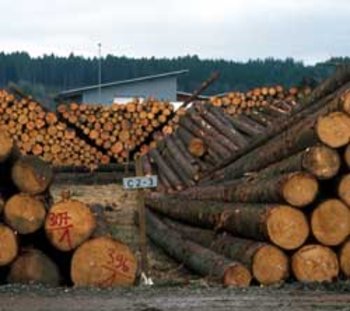Experiences after the big storms in 1990 ("Wiebke und Vivian") and 1999 ("Lothar") showed that wet conservation is the only timber conservation method which is – if carried out properly – suited to store large amounts of timber over several years (up to 4-5 years for softwood) without deterioration of quality.
Click here to download the Spanish translation of this article (PDF-file)
Method
The method is based on permanently keeping wood moisture on a high level by artificial irrigation. The wood pores remain filled with water, air can not get inside the wood. Wood destroying fungi and insects can not live without oxygen.
Advantages
- Only timber conservation method which is – if carried out properly – suited to store large amounts of timber over several years without deterioration of quality;
- Large quantities of timber can be stored in one place;
- Today, a great deal of information and know-how on wet storage technique is available;
- Wet storage as a storage method is accepted and approved by the better part of the sawmill industry.
Disadvantages
- Investment costs can be very high, depending on site properties and existing infrastructure;
- Stains can develop in the sap wood. The discolouration is caused by tannins, which can enter the wood while dissolved in water during irrigation and later during the drying process;
- Armillaria infestation has been found in wet storage, even where irrigation quality was high;
- When further processing wood from wet storage, uneven absorption of paint and glazing has occurred;
- Daily control of the technical assets is absolutely necessary. Malfunction of the irrigation system of several hours can already put success at risk.
Preconditions
- Storage location
- The site should have good transport connexion and access roads which support high loads. Sufficient water supply (esp. in summer!) is obligatory. Power supply has to be ensured where electric pumps are used.
- Water extraction
- At least 1 l/sec irrigation is required to safely conserve 1,000 cubic metres roundwood. This means a minimum hourly requirement of 3.6 cubic metres of water per 1,000 cubic metres roundwood (max. height of stacks 4 metres, which means no more than 35 cubic metres of timber per running metre!).
- Piling
- The logs are piled with the butt end facing the road, and at right angles with the road. Height of stacks may not exceed 4 metres. Logs should be sorted by length and stacked separately.
- Timber quality
- Only best quality timber is suited, low-grade timber must not be put in wet storage. Success can only be guaranteed if timber is assorted in a strictly quality oriented way.
- Daily control of the site/ the irrigation system
- High investment costs
Problems
- Coordination of primary conversion and transport capacities: as little time as possible should pass between conversion and irrigation (no longer than two weeks in cold, humid weather, immediate start of irrigation in dry, hot weather).
- Sufficient transport capacities.
- Delayed start of irrigation (not before site is completely stacked) if partial irrigation is not possible.
- Delayed administrative approval for operating wet storage sites, strict licensing requirements and conditions.
Download (in german)
Forest Crises Management Advisory Guide
Back to the main page of the Forestry Crisis Management Advisor Guide: Overview of the different topic collections
Back to the article overview in the: Storm Topic Collection – Coping with Storm Damaged Timber



